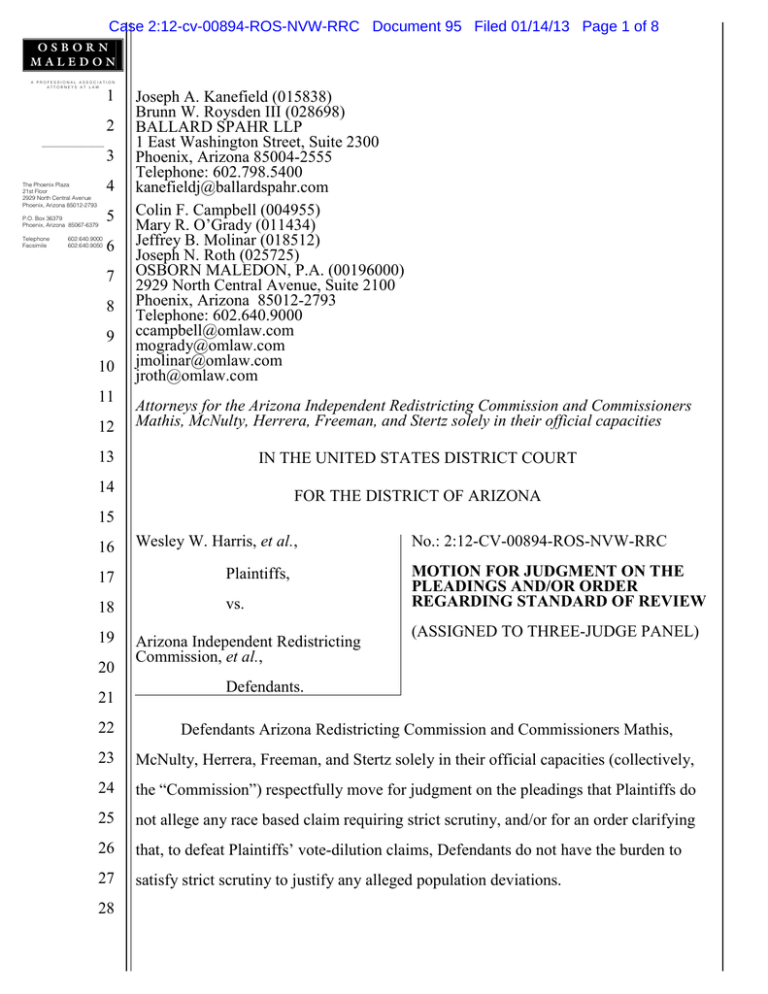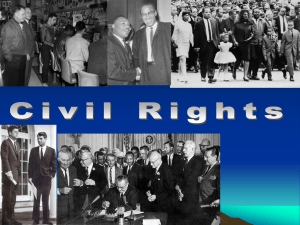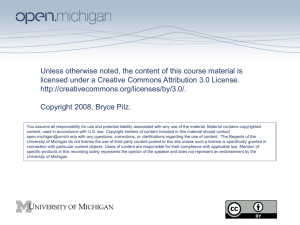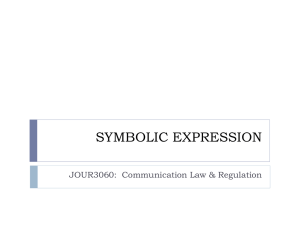1 Joseph A. Kanefield (015838) Brunn W. Roysden III (028698)
advertisement

Case 2:12-cv-00894-ROS-NVW-RRC Document 95 Filed 01/14/13 Page 1 of 8 OSBORN MALEDON A PROFESSIONAL ASSOCIATION ATTORNEYS AT LAW 1 2 ______________________ 4 The Phoenix Plaza 21st Floor 2929 North Central Avenue Phoenix, Arizona 85012-2793 P.O. Box 36379 Phoenix, Arizona 85067-6379 Telephone Facsimile 3 602.640.9000 602.640.9050 5 6 7 8 9 10 11 Joseph A. Kanefield (015838) Brunn W. Roysden III (028698) BALLARD SPAHR LLP 1 East Washington Street, Suite 2300 Phoenix, Arizona 85004-2555 Telephone: 602.798.5400 kanefieldj@ballardspahr.com Colin F. Campbell (004955) Mary R. O’Grady (011434) Jeffrey B. Molinar (018512) Joseph N. Roth (025725) OSBORN MALEDON, P.A. (00196000) 2929 North Central Avenue, Suite 2100 Phoenix, Arizona 85012-2793 Telephone: 602.640.9000 ccampbell@omlaw.com mogrady@omlaw.com jmolinar@omlaw.com jroth@omlaw.com 12 Attorneys for the Arizona Independent Redistricting Commission and Commissioners Mathis, McNulty, Herrera, Freeman, and Stertz solely in their official capacities 13 IN THE UNITED STATES DISTRICT COURT 14 FOR THE DISTRICT OF ARIZONA 15 16 Wesley W. Harris, et al., 17 Plaintiffs, 18 vs. 19 20 21 22 Arizona Independent Redistricting Commission, et al., No.: 2:12-CV-00894-ROS-NVW-RRC MOTION FOR JUDGMENT ON THE PLEADINGS AND/OR ORDER REGARDING STANDARD OF REVIEW (ASSIGNED TO THREE-JUDGE PANEL) Defendants. Defendants Arizona Redistricting Commission and Commissioners Mathis, 23 McNulty, Herrera, Freeman, and Stertz solely in their official capacities (collectively, 24 the “Commission”) respectfully move for judgment on the pleadings that Plaintiffs do 25 not allege any race based claim requiring strict scrutiny, and/or for an order clarifying 26 that, to defeat Plaintiffs’ vote-dilution claims, Defendants do not have the burden to 27 satisfy strict scrutiny to justify any alleged population deviations. 28 Case 2:12-cv-00894-ROS-NVW-RRC Document 95 Filed 01/14/13 Page 2 of 8 1 As explained in the order deciding Defendants’ motion to dismiss, Plaintiffs 2 “allege that the Commission systematically overpopulated Republican districts and 3 under-populated Democratic districts for the sole purpose of maximizing Democratic 4 Party strength.” (11/16/2012 Order, Doc. 54 at 5.) Because population deviation is less 5 than 10%, Plaintiffs have the burden to prove that “any [population] deviation is an 6 arbitrary or discriminatory policy” and that “the asserted unconstitutional or irrational 7 state policy is the actual reason for the deviation.” (See id. at 4-5 (internal quotation 8 marks and citation omitted).) 9 Despite the apparently settled standard of review for Plaintiffs’ claims, Plaintiffs 10 have indicated that they will also try to hold Defendants to a strict scrutiny standard for 11 at least some of the alleged population deviations. In the proposed case management 12 plan (Doc. 61), Plaintiffs stated that a disputed legal issue is: “Whether the IRC’s 13 underpopulations were allowable to attain and protect representational diversity states a 14 racial and ethnic motivation for the IRC’s discriminatory patterns of deviation invoking 15 strict scrutiny.” (Doc. 61 at 7.) Plaintiffs do not offer any explanation of the legal 16 principles or other basis for this purported legal issue. 17 To the extent this statement is intended to assert that some or all of the 18 Commission’s reasons for under-population of certain districts are subject to strict 19 scrutiny, the Commission respectfully requests an order clarifying that strict scrutiny 20 does not apply and that the burden remains on Plaintiffs’ shoulders. Although the 21 Commission surely could satisfy any level of scrutiny, Plaintiffs lack any basis to 22 require the Commission to spend resources preparing for and defending population 23 deviations under the strict scrutiny standard. The applicable standard is a deferential one 24 which presumes that the Commission has acted in good faith to achieve population 25 equality and puts the onus on Plaintiffs to convincingly prove otherwise. 26 27 Requiring the Commission to satisfy strict scrutiny under these circumstances would upend the deferential standard and would disregard the Supreme Court’s warning 28 2 Case 2:12-cv-00894-ROS-NVW-RRC Document 95 Filed 01/14/13 Page 3 of 8 1 that “Federal-court review of districting legislation represents a serious intrusion on the 2 most vital of local functions.” Miller v. Johnson, 515 U.S. 900, 915 (1995). 3 Plaintiffs’ claims are not subject to strict scrutiny for at least two reasons. 4 First, Plaintiffs have not and cannot allege that race “predominated” as a factor 5 for the redistricting of any of the allegedly under-populated districts. See Bush v. Vera, 6 517 U.S. 952, 962-63 (1996). In fact, Plaintiffs’ claims depend in part explicitly on the 7 theory that race was subordinated to political motivations, not the other way around. See 8 id. at 962 (“For strict scrutiny to apply, traditional districting criteria must be 9 subordinated to race.”) (See also Second Am. Compl., Doc 55 at 33 ¶ 135 (alleging 10 that Commission “refused” to move certain Hispanic voters “for the sole reason of” 11 partisan motivations)). 12 Second, even if Plaintiffs attempt to make out a claim that a district was under- 13 populated predominantly because of race (which likely would be subject to strict 14 scrutiny), they lack standing to assert such a claim. 15 I. Plaintiffs Have Not and Cannot Allege Any Claim Subject to Strict Scrutiny. 16 Plaintiffs are electors residing in allegedly over-populated and Republican- 17 plurality legislative districts. (Second Am. Compl., Doc. 55 at 34.) They allege that the 18 Commission deliberately overpopulated Republican-plurality districts and under- 19 populated Democrat-plurality districts in violation of equal protection. (Id. at 2-3.) 20 They do not allege a racial gerrymander, see Shaw v. Reno, 509 U.S. 630 (1993), or 21 otherwise contend that the Commission impermissibly used race in drawing of district 22 lines. 23 Nevertheless, Plaintiffs apparently believe that strict scrutiny is “invok[ed]” if 24 “the IRC’s underpopulations were allowable to attain and protect representational 25 diversity” such that there was “a racial and ethnic motivation for the IRC’s 26 discriminatory patterns of deviation.” (Doc. 61 at 7.) Although Plaintiffs’ position 27 statement is unclear, it appears that Plaintiffs believe that strict scrutiny should apply if 28 the Commission asserts that the creation of majority-minority districts in compliance 3 Case 2:12-cv-00894-ROS-NVW-RRC Document 95 Filed 01/14/13 Page 4 of 8 1 with the Voting Rights Act justified population deviations. This is legally flawed, would 2 impermissibly expand the scope of this case at trial, and would improperly reduce 3 Plaintiffs’ heavy burden to overcome the presumption that the minor population 4 deviations at issue in this case are constitutional. See Brown v. Thomson, 462 U.S. 835, 5 842-43 (1983). 6 Strict scrutiny applies in districting cases in very narrow circumstances. It may 7 apply to a claim of racial gerrymandering when “redistricting legislation . . . is so 8 extremely irregular on its face that it rationally can be viewed only as an effort to 9 segregate the races for purposes of voting, without regard for traditional districting 10 principles.” Shaw, 509 U.S. at 642. Strict scrutiny also applies when “race for its own 11 sake, and not other districting principles, was the legislature’s dominant and controlling 12 rationale in drawing its districting lines” and when the legislative body “subordinated 13 traditional race-neutral districting principles . . . to racial considerations.” Bush, 517 14 U.S. at 958 (quoting Miller, 515 U.S. at 913, 916). 15 It is equally clear that “[s]trict scrutiny does not apply merely because 16 redistricting is performed with consciousness of race.” Id. (citing Shaw, 509 U.S. at 17 646). “Nor does it apply to all cases of intentional creation of majority-minority 18 districts.” Id. To get to strict scrutiny, the key is that “traditional districting criteria 19 must be subordinated to race.” Id. at 962. In other words, strict scrutiny applies only if 20 race is “the predominant factor motivating the legislature’s [redistricting] decision.” Id. 21 at 959 (quoting Miller, 515 U.S. at 916) (emphasis in quotation but not in original). 22 Thus, to trigger strict scrutiny in this case Plaintiffs would have had to assert that the 23 under-populated districts were under-populated because of race, or that race was the 24 predominant factor driving the decision to under-populate.1 25 26 27 28 1 Of course, if such a claim were asserted Plaintiffs would also have to allege that the alleged race-based redistricting decision failed to be narrowly tailored to serve a compelling state interest. See Bush, 517 U.S. at 976. 4 Case 2:12-cv-00894-ROS-NVW-RRC Document 95 Filed 01/14/13 Page 5 of 8 1 To the extent Plaintiffs’ claims even address race-conscious districting decisions 2 at all, however, they assert claims that preclude the application of strict scrutiny. 3 Indeed, Plaintiffs’ claims depend on partisanship—not race—being the predominant 4 factor in the Commission’s decisions to deviate from strict population equality. For 5 example, when discussing the Commission’s alleged treatment of Hispanic-majority 6 voting precincts, Plaintiffs allege that the Commission “deliberately separated these 7 highly Hispanic precincts from [majority-minority districts] to use their Democratic 8 votes to shore up the partisan composition of neighboring Democrat-plurality districts, 9 and or to directly or indirectly weaken Republican-plurality districts.” (Second Am. 10 Compl., Doc. 55 at 31-32 ¶ 130.) Plaintiffs also allege that the Commission “refused” to 11 move Hispanic voters in certain ways “for the sole reason of increasing the Democrat 12 percentages of the vote in the districts adjacent to these seven districts.” (Id. at 33 ¶ 13 135.) 14 From these examples and multiple other allegations, it is evident that Plaintiffs’ 15 claims are premised on a theory that the Commission subordinated race to other 16 districting factors. The opposite is required for strict scrutiny. Moreover, the Supreme 17 Court has already clarified that politically motivated districting decisions are not subject 18 to strict scrutiny. Bush, 517 U.S. at 964 (“We have not subjected political 19 gerrymandering to strict scrutiny.”)2 Consequently, Plaintiffs claims are not subject to 20 strict scrutiny and the Commission respectfully requests an order declaring that the 21 Commission need not survive strict scrutiny to defeat Plaintiffs’ claims at trial. 22 II. Plaintiffs Lack Standing To Assert Any Claim Subject To Strict Scrutiny. 23 24 The gist of Plaintiffs’ legal position seems to be that to the extent the Commission under-populated any districts to preserve minority voting strength, those under- 25 26 27 28 2 After the split decision in Vieth v. Jubelirer, it is unclear whether political gerrymandering claims are justiciable at all much less subject to strict scrutiny. 541 U.S. 267, 312-13 (2004) (Kennedy, J., concurring) (agreeing with plurality that existing standard for political gerrymandering claim is unworkable but declining to hold that issue is forever non-justiciable). 5 Case 2:12-cv-00894-ROS-NVW-RRC Document 95 Filed 01/14/13 Page 6 of 8 1 populations would fail to survive strict scrutiny. (See Doc. 61 at 7 (quoting Shaw v. 2 Reno, 509 U.S. at 642-43; Abrams v. Johnson, 521 U.S. 74, 91 (1997); and Miller v. 3 Johnson, 515 U.S. at 904).) Even if Plaintiffs attempted to amend their complaint to 4 allege such a claim, they lack standing to do so. 5 At a minimum, the Constitution requires that the plaintiff must sufficiently allege 6 an “injury in fact.” United States v. Hays, 515 U.S. 737, 742-43 (1995) (holding that 7 plaintiff lacked standing to bring racial gerrymandering claim when plaintiff resided in 8 different district). An “injury in fact” is an “invasion of a legally protected interest that 9 is (a) concrete and particularized, and (b) actual or imminent, not conjectural or 10 hypothetical.” Id. at 743 (quoting Lujan v. Defenders of Wildlife, 504 U.S. 555, 560 11 (1992)). In addition, “there must be a causal connection between the injury and the 12 conduct complained of . . . and . . . it must be likely, as opposed to merely speculative, 13 that the injury will be redressed by a favorable decision.” Id. (quoting Lujan at 504 U.S. 14 at 560-61). 15 The Supreme Court has carefully policed standing in this area. To assert that a 16 district was racially gerrymandered (i.e., that the district lines were impermissibly drawn 17 because of race), for example, a plaintiff must (1) reside in the gerrymandered district or 18 (2) show personal constitutional injury by producing evidence that the plaintiff was 19 “assigned to his or her district as a direct result of having ‘personally been subjected to a 20 racial classification.’” Sinkfield v. Kelley, 531 U.S. 28, 30 (2000) (quoting Hays, 515 21 U.S. at 745). Without such proof, there is no cognizable injury. Id. at 31 (quoting 22 Hays, 515 U.S. at 746). 23 This is so even when the plaintiff’s own, adjacent district’s shape and racial 24 make-up are impacted by the gerrymandering that occurred in a neighboring district. 25 That is, the fact that plaintiffs could state a racial gerrymandering claim “with respect to 26 a majority-minority district” does not “prove anything with respect to a neighboring 27 majority-white district in which [plaintiffs] resided.” Id. at 30-31 (internal quotation 28 marks and citation omitted). Although residents of a neighboring district may 6 Case 2:12-cv-00894-ROS-NVW-RRC Document 95 Filed 01/14/13 Page 7 of 8 1 experience practical, indirect effects of racial gerrymandering, they have not “suffer[ed] 2 the special representational harms racial classifications can cause in the voting context.” 3 Hays, 515 U.S. at 745. 4 The same analysis applies here. Plaintiffs all allege that they reside in various 5 overpopulated districts, some of which border under-populated, majority-minority 6 districts. Under the reasoning of Shaw, Hays, and Sinkfield, to show a constitutionally 7 sufficient “injury in fact” caused by race-based under-population, plaintiffs would have 8 to show either (1) that they resided in the under-populated district, or (2) that they were 9 “assigned to his or her district as a direct result of having ‘personally been subjected to a 10 racial classification.” Sinkfield, 531 U.S. at 30 (quoting Hays, 515 U.S. at 745). None 11 of the allegations in the Second Amended Complaint come remotely close to making 12 such a showing. Plaintiffs therefore lack standing to assert a claim that the 13 Commission’s under-population of certain majority-minority districts fail to survive 14 strict scrutiny. If Plaintiffs contend that their vote was impermissibly diluted, they must 15 prove their claim under the deferential standard set forth for vote-dilution claims. See, 16 e.g., Brown, 462 U.S. at 842-43; Daly v. Hunt, 93 F.3d 1212, 1220 (4th Cir. 1996); 17 Larios v. Cox, 305 F. Supp. 2d 1335, 1339 (N.D. Ga. 2004); Marylanders for Fair 18 Representation v. Schaefer, 849 F. Supp. 1022, 1032 (D. Md. 1994) (plaintiff must show 19 that an “asserted unconstitutional or irrational state policy is the actual reason for” a 20 population deviation). 21 22 III. Conclusion Plaintiffs are not alleging a race-based vote dilution claim under Section 2 of the 23 Voting Rights Act, a racial gerrymandering claim, or any other race-based claim that 24 may be subject to strict scrutiny. As this Court already made clear, Plaintiffs claim is a 25 purely a partisan one. Consequently, the Commission respectfully requests an order 26 declaring that the Commission need not survive strict scrutiny to defeat Plaintiffs’ 27 claims and that Plaintiffs have the burden to overcome the presumption that Commission 28 made a good faith effort to create districts of equal population. 7 Case 2:12-cv-00894-ROS-NVW-RRC Document 95 Filed 01/14/13 Page 8 of 8 1 RESPECTFULLY SUBMITTED this 14th day of January, 2013. 2 OSBORN MALEDON, P.A. 3 4 By 5 6 s/ Colin F. Campbell Colin F. Campbell (004955) Mary R. O’Grady (011434) Jeffrey B. Molinar (018512) Joseph N. Roth (025725) 7 8 BALLARD SPAHR LLP 9 By: 10 11 12 s/ Joseph A. Kanefield Joseph A. Kanefield (015838) Brunn W. Roysden III (028698) Attorneys for the Arizona Independent Redistricting Commission and Commissioners Mathis, McNulty, Herrera, Freeman, and Stertz solely in their official capacities 13 14 15 CERTIFICATE OF SERVICE 16 17 18 I hereby certify that on January 14, 2013, the attached document was electronically transmitted to the Clerk of the Court using the CM/ECF System which will send notification of such filing and transmittal of a Notice of Electronic Filing to all CM/ECF registrants. 19 20 21 s/ Sara C. Sanchez 4631909v3 22 23 24 25 26 27 28 8





